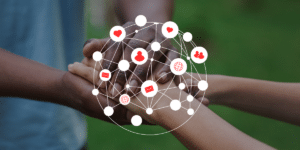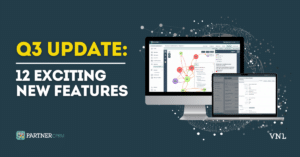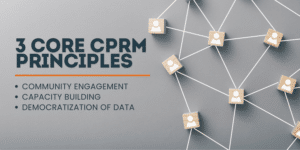
The Ethics of Social Network Analysis: What Could Go Wrong?
"Any tool can be used for good or bad. It's really the ethics of the analyst using it."
⏤ John Knoll Tweet
Believe it or not, social network analysis has a lot of ethical pitfalls you might be unaware of. Unlike traditional survey research, social network analysis relies on naming survey respondents and collecting data from them about other people, who may or may not have consented to share their own data. This inherent difference in design creates numerous ethical implications. All practitioners should be aware of these concerns so they can take a reflexive approach, questioning the ethical implications of each step in their methods. Here is a more complete analysis of the ethics of social network analysis.
What is Social Network Analysis?
Social network analysis (SNA) is a methodology for researching and evaluating an interconnected set of individuals, organizations, places, and resources. It focuses on measuring and visualizing the set of actors (nodes) that comprise the network, with a series of lines (edges) that represent relationships or engagement between two entities. From this basic network map, one can calculate numerous network measures, like centrality and density. SNA provides a unique way to understand the structure and quality of connection within a network. So what do ethics have to do with it?
The Ethics of Social Network Analysis
While all survey research has ethical implications, these are more significant during social network analysis for two reasons. First, anonymity is impossible, as nodes must be identified to connect them to others. For example, if a respondent says they are connected to “Dave” it would be impossible to connect him if the “Dave” node has been anonymized. Second, while respondents themselves consent, those they answer about often do not consent, raising questions about what information is public, and what is not. These differences lead to these four issues.
1: Anonymity among Respondents
Anonymity among network survey respondents is almost always inherently impossible to achieve. As discussed above, the names of individuals and organizations must be saved to match them to others who identify them and establish a common frame of reference. While the data can be de-identified later in the process, there are often ways for them to be identified. For example, one infamous paper that used Facebook data and de-identified participants was still linked back to their identities within a few days of publication.
2: Privacy Rights among Non-Respondents
In a network survey, respondents answer questions about themselves, but also about their relationships with others in the network. These other individuals do not have an opportunity to decline consent, meaning their name and information may be included in a final result without their approval. This is a gray area that requires careful consideration, especially about the context of your network. For example, a social network analysis researching HIV transmission may want to tread carefully in this area, reaching out to all those mentioned due to the protected nature of the topic. The important thing is to reflect on the nature of the data you collect to consider how it could harm others, from their own perspective.
3: Pychological Harm or Harm to Standing
The lack of anonymity in a social network analysis project can have repercussions involving a respondent’s standing or psychological well-being. Network data can be used for good or malicious purposes. For example, health insurers could use social network analysis to identify socially isolated patients and raise their premiums accordingly. Similarly, a business could use this method to identify bottlenecks or informal structures to eliminate for efficiency. Network respondents should be made aware early on about how their participation could impact them later on.
4: Survey Non-Response Issues
One of the unique aspects of social network analysis is the necessity for high response rates. If you remove one or two key nodes in a network it can significantly change the outcome of the entire project. For example, consider a network of ten people that relies on a single, central node to connect them. If that central node failed to answer a survey to report their relationships, the network map would look like 10 unconnected individuals. This can lead researchers to understate the risks of participation in an attempt to boost their response rate. It is important to be open and honest about how a social network analysis could impact respondents negatively from the start.
5: Digital Network and Privacy Issues
Cambridge Analytica and other recent situations demonstrate the troubling intersection of social network analysis and social media privacy issues. The rise of websites like Facebook, Twitter, and LinkedIn provides researchers an easy way to gather information on thousands of social network ties. This has exacerbated all of the above ethical implications that involve social network analysis. Whenever you’re using digital data sources, be extra careful to ensure you are following all relevant laws and data privacy policies, along with the broader ethical considerations that are involved.
Tips for Ethical Social Network Analysis
In a recent paper on the subject of the ethics of social network analysis, the authors recommend using a process of reflexivity. They describe this as “a process—an active, ongoing process that saturates every stage of the research.” Reflexivity helps the social network researcher to pause and consider what is going on, to think about how to respond, to react in an appropriate way and to learn lessons about how future such situations might be addressed
The Ethics of Social Network Analysis: Now You Know!
While all research methods pose unique questions for practitioners, social network analysis is rarely considered an ethically involved practice. It is important to remind ourselves and our colleagues about the ways that network data can be used for malicious purposes or unintentionally harm those it intends to serve. By being a reflexive researcher and carefully considering the ethical implications of your work, it is possible to conduct social network analysis research while limiting its potentially harmful impacts. It just takes the right mindset and information to be able to act.

About the Author: Alex Derr, M.P.A.
Director of Marketing & Communications
Alex joined VNL in 2017, originally supporting our events. He now helps manages our communications and marketing strategy and content development work. Alex creates blogs, infographics, reports, and other content while managing our web and social media presence. He also runs our email marketing campaigns, tracks analytics, and conducts market research to drive our strategy. He supports our entire team with copywriting, graphic design and research, and helps with events, webinars, demos, and other online learning. When he isn’t at work Alex spends his time climbing 14ers (30 done, 28 to go!) and blogging on his own website, The Next Summit Blog.




